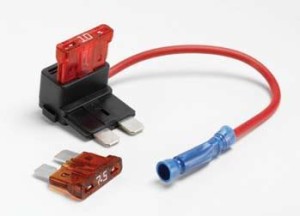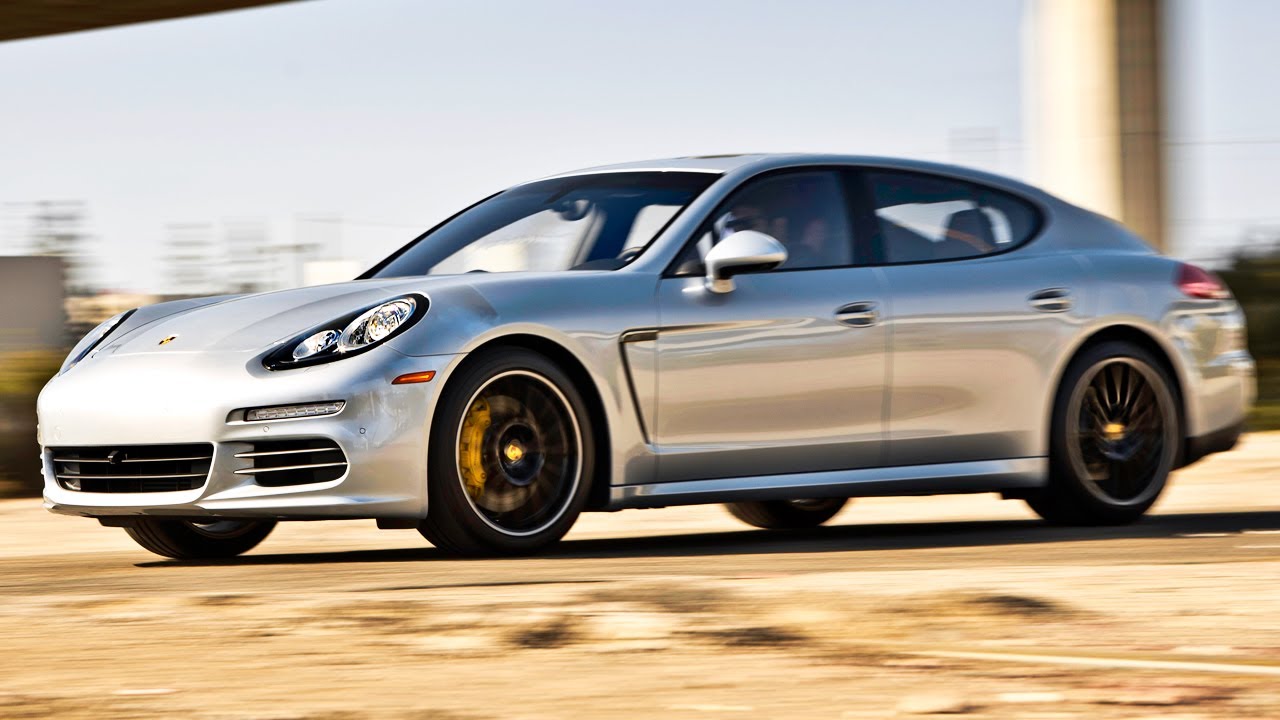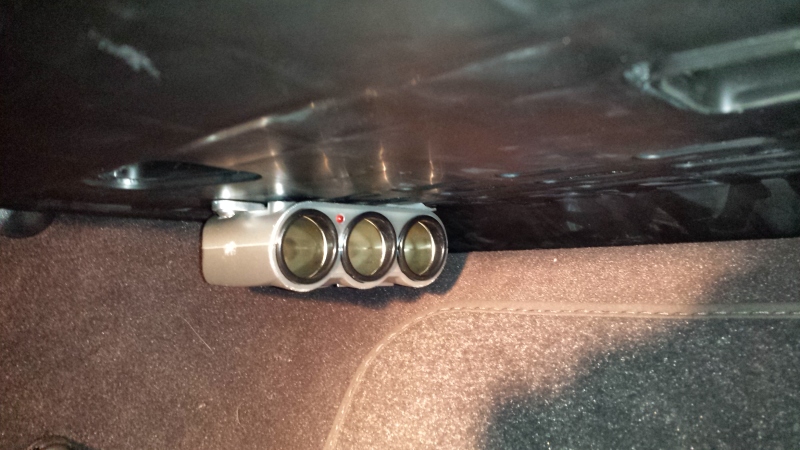2013 Porsche Panamera GTS Review
0-60: 4.1 s
1/4 mile: 12.7 107.2 mph
Stop: 106ft
NEW GTS!
The new Panamera GTS is based on the Panamera 4S and includes more power, upgraded
brakes and a body lowered by ten millimeters with new sportier chassis tuning coupled to air
suspension and Porsche Active Suspension Management (PASM). These technical
modifications make the Panamera model even more capable of cutting it on the race track
without sacrificing practicality. The sportiest of all Panamera models also conveys this to
occupants and the outside world by its striking sound. In terms of looks, the new Panamera
GTS includes distinctive design features at the front, side and rear as well as black
highlights. The interior is also tailored to its sporty personality with adaptive sports seats,
SportDesign steering wheel with shift paddles and exclusive GTS leather interior with
Alcantara surfaces.
The Panamera GTS powered by a modified 4.8-liter naturally aspirated V8 engine, delivering
430 hp at 6,700 rpm, increasing the output over the Panamera S/4S by 30 hp. The
maximum torque also increases by comparison, from 369 to 384 lb. ft. At the push of a
button, thanks to the standard Sport Chrono package, the 7-speed Porsche
Doppelkupplungsgetriebe (PDK) transmission transmits the engine output to the all-wheel
drive system without interruption to the power flow. This collaboration enables the Panamera
GTS to sprint to 60 mph in 4.3 seconds, accelerating on to its top track speed of 178 mph.
The 0-60 figures and top speed only scratch the surface of the new Panamera GTS’s sporty
character. Its chassis in particular makes it fit for the race track: the adaptive air suspension
and Porsche Active Suspension Management (PASM) connect the chassis and body,
constantly adapting to the driving challenges by regulating leveling settings, adjusting height,
adjusting the spring rate and electrically adjusting the damping system. The body has been
lowered by ten millimeters and the damping designed to be tauter, which helps agility and
further reinforces the sporty personality of the Panamera GTS. Five millimeter wheel spacers
between the wheel and the wheel hubs increase the rear axle track width, giving the
Panamera even more stability. The required grip is provided by standard 255/45 size 19-
inch tires on the front axle and 285/40 on the rear axle. Optional 20-inch tires are available
in 255/40 on the front and 295/35 on the rear.
Deceleration on the sporty Panamera is provided by the braking system from the Panamera
Turbo, which includes larger diameter front brake rotors than Panamera S/4S. Like all other
Porsche models, the Panamera is available with the optional Porsche Ceramic Composite
Brakes (PCCB), featuring brake calipers finished in yellow.
The sports car among Sports Sedans
The Panamera GTS is the purest member of the Porsche Panamera family. The heart of the
new Panamera GTS is its upgraded 4.8-liter naturally aspirated V8 engine benefiting from
numerous modifications to give it even better performance. Compared with the Panamera
S/4S, these modifications result in a 30 hp increase in engine output and an increase in
torque of 15 lb. ft. to 384 lb. ft. at 3,500 rpm.
To achieve these enhancements, the engineers increased the speed at which the engine
reaches peak power by 200 rpm; the GTS’s eight-cylinder engine achieves maximum output
at 6,700 rpm. Redline was extended by 400 rpm to 7,100 rpm. The higher engine speed
capabilities are enabled by modified valve springs, ensuring that the valves open and shut
precisely in all circumstances.
In addition to the increase in redline; the engine in the Panamera GTS employs a higher-flow
air intake system. At low speeds, flaps close each of the two air intake openings. At engine
speeds above 3,500 rpm, both flaps open and allow additional air flow into the inlet duct. In
order to be able to handle the increased flow of combustion air, two new camshafts with a
one millimeter increase in lift control the intake valves. As a result, especially at higher revs,
the engine draws in more air and, with it, the engine makes more power.
Hearing performance: Sound Symposer transmits intake noises
At the push of the Sport button, driver and passengers can hear the GTS engine “breathing”
even more than usual: a ‘Sound Symposer’ directs the intake sounds into the interior at the
push of a button. This is accomplished with the addition of an acoustic channel, which picks
up the intake vibrations between the throttle valve and air filter. The acoustic channel
incorporates a membrane that transmits the vibrations as an engine sound into the A-pillar. A
controllable valve located in front of the membrane enables the Sound Symposer to be activated or deactivated by means of the Sport button.
Exhaust gases exit the Panamera GTS through a standard sport exhaust system. This
exhaust comes with larger diameter pipes to reduce back pressure and black exhaust tips.
This too is another building block toward increased power output, and one which adds
additional aural excitement: the sport exhaust system features two tuning flaps, which
expose additional exhaust openings, thereby emitting an even more powerful sound. The
flaps are controlled by a switch in the center console, which features a “last mode” function
that remembers the last setting when the engine is restarted.
The control of the GTS engine is handled by modified and upgraded engine controls. The
new system has been tuned for improved torque and responsiveness. The modified engine
management system also enables a brief shutoff of individual cylinders when changing
gears, allowing the engine speed to adjust even faster to the transmission speed. This
further reduces gear change times and is accompanied a short, sharp report from the
exhaust system, particularly audible when downshifting in Sport mode.
Sport Chrono Plus Package for individual sportiness
The Panamera GTS comes standard with the Sport Chrono package, which in addition to
Normal and Sport modes offers a Sport Plus program as well. Specific characteristics of the
Panamera GTS are further accentuated depending on which mode is selected: for example,
activating Sport Plus mode enhances gear-shift parameters and throttle response and
includes Launch Control for faster off-the-line acceleration.
Moreover, in Sport Plus mode the Porsche Stability Management (PSM) stabilization system
intervenes later. The Sport Plus mode offers even greater agility with the PSM deactivated.
For safety’s sake however it remains on permanent standby in the background, intervening
automatically if both front wheels are in the ABS control range. In addition, the adaptive air
suspension lowers the vehicle to the low setting and switches to a harder spring rate. The
rear spoiler angle of attack also changes to the performance-oriented setting.
Options for even greater driving dynamics: PDCC and PTV Plus
Porsche Dynamic Chassis Control (PDCC) is the final level of development of the Panamera
GTS chassis, paired with an electronically controlled rear axle differential lock and PTV Plus.
PDCC prevents the body from rolling by using active stabilizers on the front and rear axle to
apply a counteracting force.
PDCC is further enhanced by Porsche Torque Vectoring Plus (PTV Plus). The system works
by varying the torque distribution to the rear wheels and by employing an electronically
regulated rear differential lock, optimizing steering behavior. Braking interventions applied to
the inside rear wheel generate an additional rotational pulse in the direction in which the
steering wheel has been turned. This results in a direct and dynamic steering action as the
car enters the curve.
PTV Plus improves steering behavior and precision by modulating braking interventions to
the rear wheels when the car is being driven in a highly dynamic way. When entering a
corner, braking force is applied to the inside rear wheel as the steering maneuver begins.
This imparts greater drive torque to the outside rear wheel and improves the car’s agility.
Panamera GTS aerodynamics package
The aerodynamics of the Panamera GTS are on par with the Panamera Turbo: with its large
air intake openings, the standard front fascia from the Panamera’s SportDesign package
emphasizes the vehicle’s sporty dynamics and ensures an optimal air supply for the larger
air filters unique to the GTS. This is matched in the rear section by fitting the adaptively
deploying four-way rear spoiler from the Panamera Turbo. At speeds of 125 mph and above,
it positions itself to generate downforce on the rear axle, thereby ensuring stable driving
safety at high speeds.
Exterior: Sporty at first glance
The exterior features a high-gloss black exterior package as standard, comprised of side
window trim, decorative trim on the rear lid, the headlight washer unit cover, the rear
diffuser and the side air outlet panels. Together with the black front fascia grills, black side
skirts, black lower rear fascia the sport exhaust system’s matte black tailpipes, the resulting
appearance is striking.
A further point of differentiation: Bi-Xenon headlights with black inner bezels. They feature
four LED daytime running lights. Optional paintwork in Carmine Red, available exclusively for
the Panamera GTS, emphasizes the vehicle’s sportiness and provides an ideal contrast with
the black exterior accessories.
Interior: Acceleration display, unique appointments
The Panamera GTS includes a lateral and longitudinal acceleration display. The multi-function
display in the instrument cluster and the Porsche Communication Management (PCM) system
informs the driver about the instantaneous acceleration.
The Panamera GTS’s interior includes leather and Alcantara trimmed seats in a choice of five
colors. The standard adaptive 18-way adjustable sport seats feature Alcantara center
panels. Alcantara trim is also used on the upper sections of the door armrests and front
center console armrest, as well as the roofliner. The SportDesign steering wheel with shift
paddles and a twelve hour marking on the steering wheel combines dynamic looks with
sporty functionality. This steering wheel can also be clad with black Alcantara if so desired.
To ensure clear differentiation, the front brushed aluminum door entry guards are adorned
with “Panamera GTS” lettering. “GTS” lettering is also found in the instrument cluster and on
the embroidered headrests.
Porsche has put together two special optional interior equipment packages for the
Panamera GTS. These packages marry a black interior with decorative stitching on the
seats, foot mats, dashboard, door panels, center console armrest and doors, executed in
Carmine Red or GT silver. Embroidered “GTS” lettering on the headrests and safety belts is
also in the corresponding color.
Image Credit: Copyright 2011 Michael Harley / AOL
Panamera DIY – Ignition powered cigarette lighter adapter
Ok, as we know, all cigarette lighter sockets DO NOT TURN off when you turn the car OFF.
I started using drivecam in my car ever since I had an accident and needed proof. So I needed a power outlet that turns off with ignition. Some people need that to run their Radar detectors.
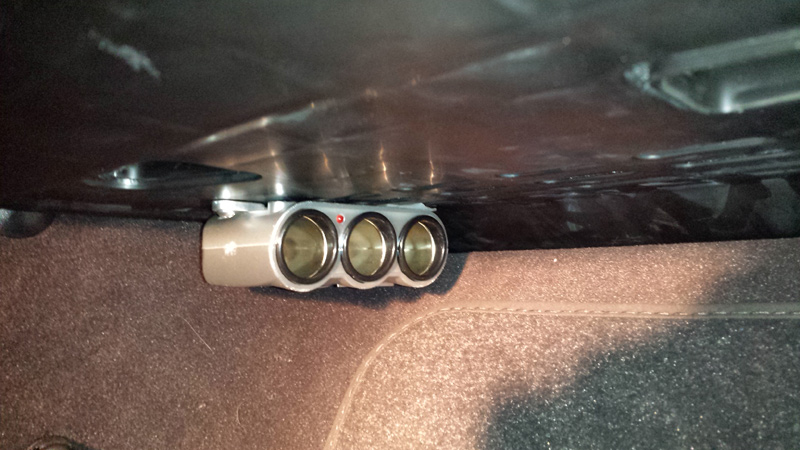
1 – What I did is I went to the local autozone and picked up a power outlet receptacle (picture)
2- Then I cut off the end where the the plug is. On the positive end of the wire I installed a push on MALE connector (picture). On the negative I put on Female connector. Right before the positive tip, I installed a IN LINE FUSE 20A (picture).
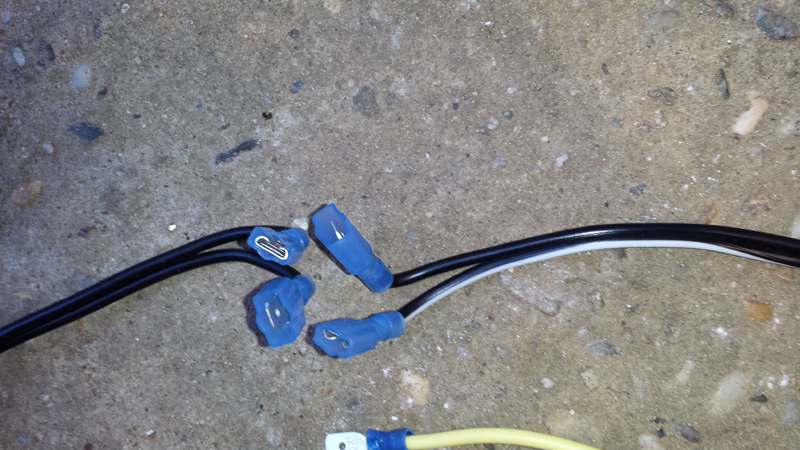
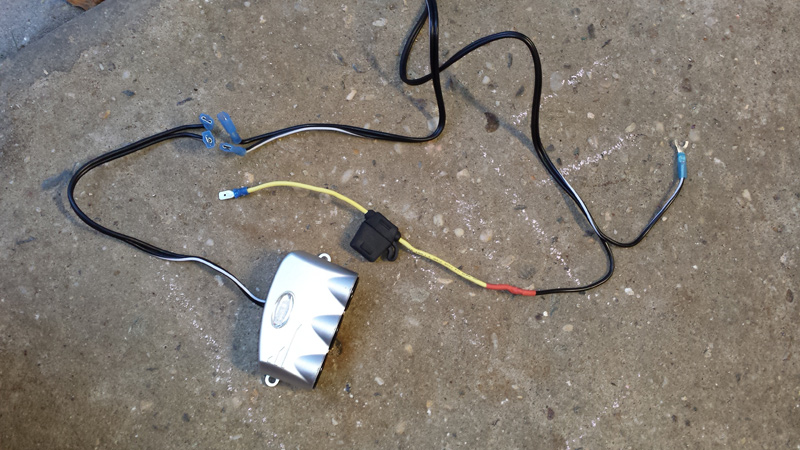
3 – Remove cover under dashboard on the passenger’s side. Pull the cover down -arrow- and unclip locking lugs. Then pull out cover for footwell.
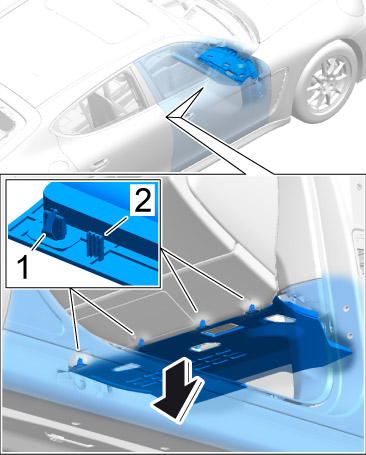
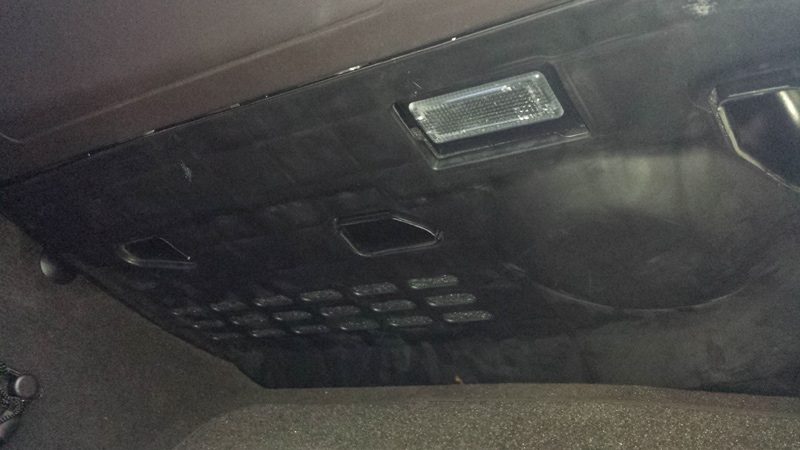
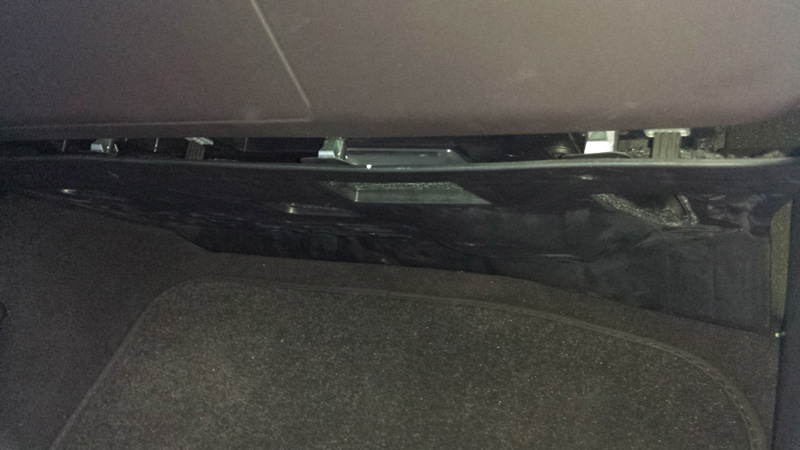
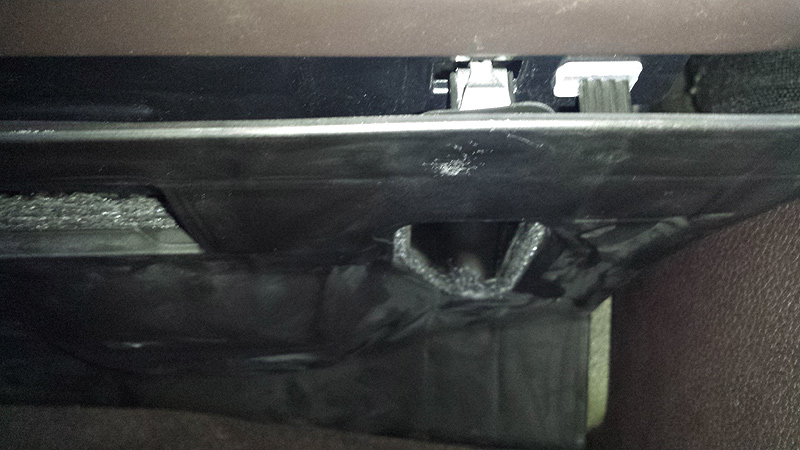
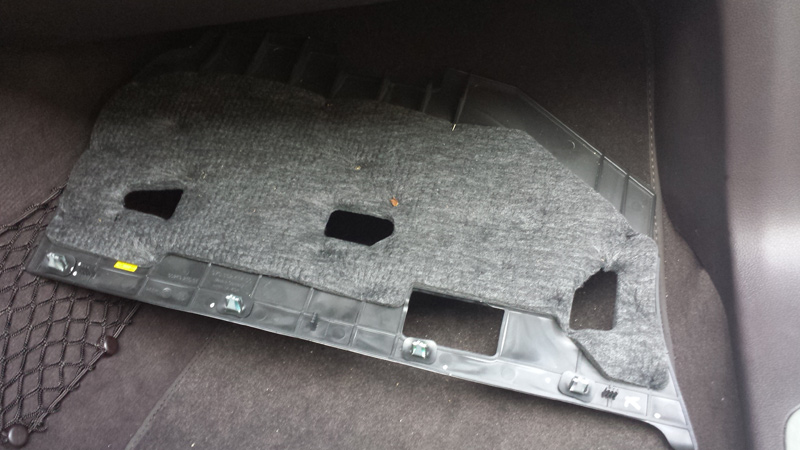
4 – I dropped the top plastic panel (held by 4 tabs) from the passenger footwell. I took that panel and screwed the splitter with 2 screws and 3M double stick tape. I ran the wire through one of the holes in the plastic.
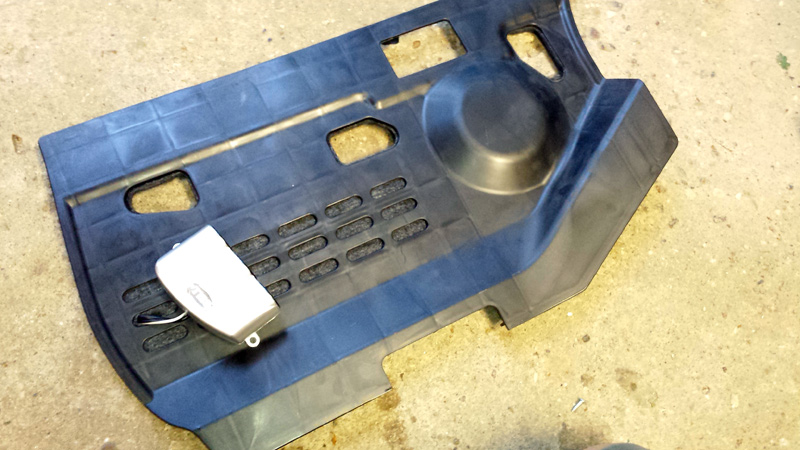
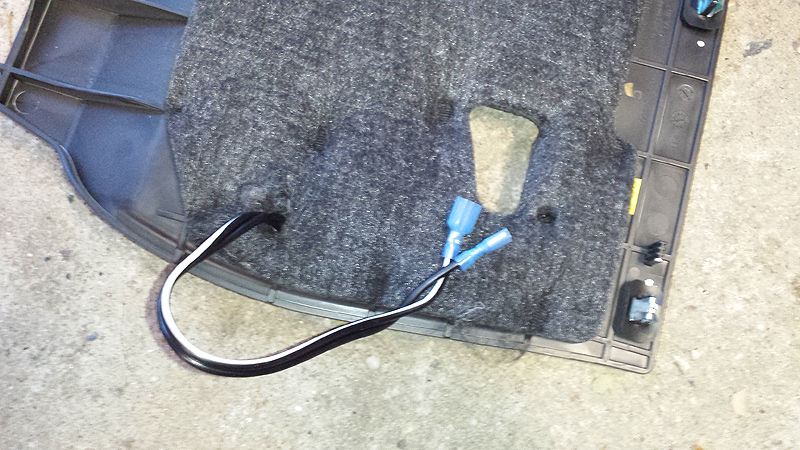
5 – Then I cut the wire about 10 inches away from the receptacle and installed 2 flat wire connectors on each positive and negative lead (purpose of that is to disconnect it when you remove the panel from the car when you are doing something else)
6 – I ran the wire from the right side fuse box to the bottom of the footwell (its very easy to find a hole)
7- I connected the male/female connectors to the receptacle and put the cover back on.
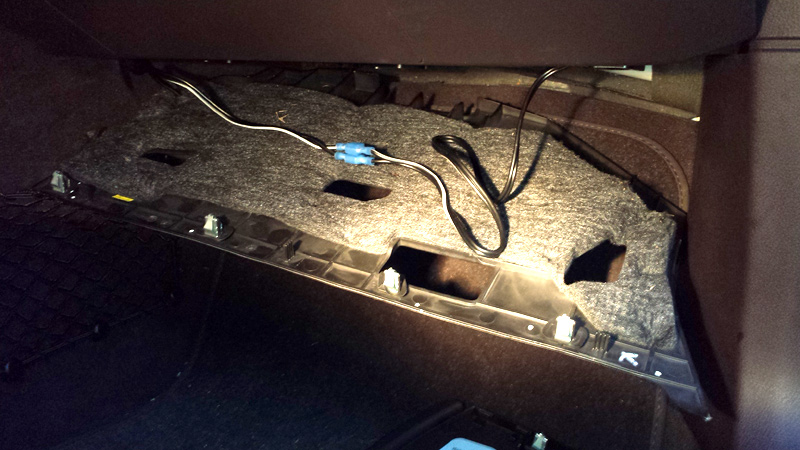
8 – Now the challenge was to find a fuse or an emply space that shuts of with ignintion. I was only able to find a 4 fuses that do that and it doesnt really screw with important circuits.
The circuits that you may use are the Cooled seats (fuse #24 and #25) and Adaptive cruise control (fuse #23). So I just tapped into that circuit with postive lead and I hooked up the negative lead to the frame (big bolt that next to the fuse panel). I did that because I dont have cooled seats and I have no Adaptive CC. I actually tapped into #23.
Thats it.
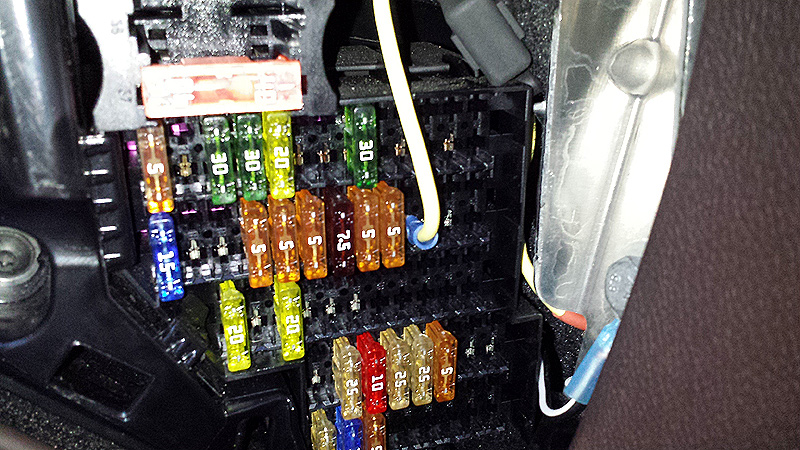
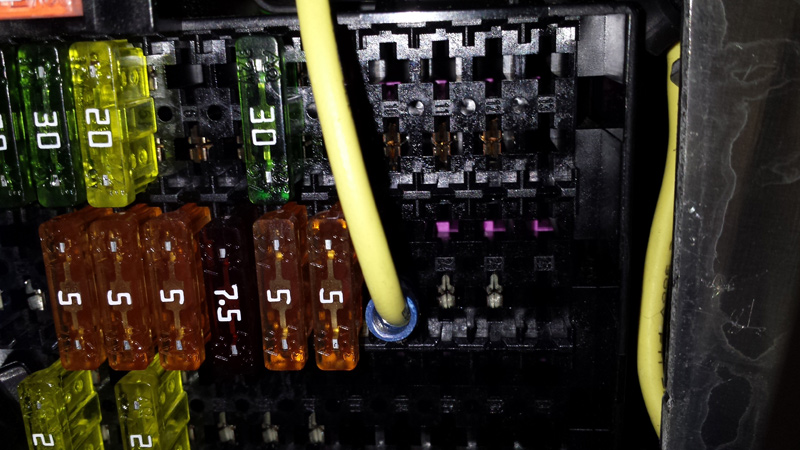
* IMPORTANT: Some of you may actually have these options working so you will have to get a FUSE TAP and not a IN LINE FUSE.
